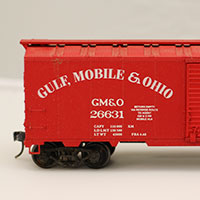 |
Gulf, Mobile & Ohio Scale Modeling |
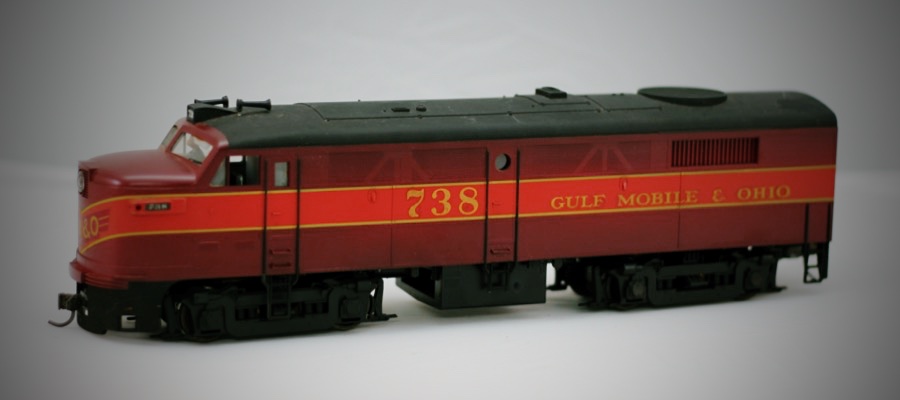
Jul 2020 / RWH
 Article
Article
Modeling Some GM&O Diesels
January 1996
In the 1950's and 1960's many railfans were enthusiastic followers of the Gulf, Mobile & Ohio Railroad. The G.M.& O. stretched from Chicago and St. Louis down to New Orleans and Mobile, passing through Illinois, Kentucky, Tennessee, Mississippi, Alabama and Louisiana to arrive at the two Gulf ports it served. Powering the freight trains of the G.M.& O. were a number of interesting first and second generation diesel locomotives. The G.M.& O. was the first major Class 1 railroad to completely dieselize and this was done using both Alco and EMD cab units for road work and Alco units for switchers.
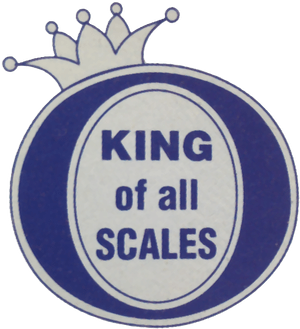 Because I was around then, it was my good luck to have seen many of the first and second generation locomotives in action! Memory goes back far enough to recall a FA-FB-FB-FA set on the New Orlean-bound freight crossing the Southern Railway Lake Pontchartrain bridge just after daybreak. Or a four unit consist of GP-35's with a long freight on the winding ex-Mobile & Ohio line north of Meridian, Mississippi. Now that the G.M.& O. has been gone for almost a quarter of a century, it's great fun to recreate in O scale some of their trains and power them with authentic model locomotives. Maybe you'll be motivated to model a G.M.& O. train or locomotive from this.
Because I was around then, it was my good luck to have seen many of the first and second generation locomotives in action! Memory goes back far enough to recall a FA-FB-FB-FA set on the New Orlean-bound freight crossing the Southern Railway Lake Pontchartrain bridge just after daybreak. Or a four unit consist of GP-35's with a long freight on the winding ex-Mobile & Ohio line north of Meridian, Mississippi. Now that the G.M.& O. has been gone for almost a quarter of a century, it's great fun to recreate in O scale some of their trains and power them with authentic model locomotives. Maybe you'll be motivated to model a G.M.& O. train or locomotive from this.
 I purchased a six-car streamlined partially built G.M.& O. passenger train at the 1991 0 Scale meet in High Point, NC. It needed interiors and a lot of finishing work but was complete with trucks and for $150 it was too good to pass up. To my mind, the observation car looked like one of the cars used on the Chicago - St. Louis trains, the Ann Rutledge, and the rest of the train resembled a modernized Gulf Coast Rebel. What could I use for power? The natural answer to me was a Weaver FA2 and FB2. The G.M.& O.'s FA units were FA1's and not FA2's like the Weaver units. The G.M.& O. FA1's were divided into two groups that looked different. The first group, 700-735 had a low mounted headlight (unique to these 36 units) and a curved trim strip on each side behind the cab door. The second group, 736-754, looked like the FA1's except for the fan. The fan on the FA2 is more toward the rear than on the FA1.
I purchased a six-car streamlined partially built G.M.& O. passenger train at the 1991 0 Scale meet in High Point, NC. It needed interiors and a lot of finishing work but was complete with trucks and for $150 it was too good to pass up. To my mind, the observation car looked like one of the cars used on the Chicago - St. Louis trains, the Ann Rutledge, and the rest of the train resembled a modernized Gulf Coast Rebel. What could I use for power? The natural answer to me was a Weaver FA2 and FB2. The G.M.& O.'s FA units were FA1's and not FA2's like the Weaver units. The G.M.& O. FA1's were divided into two groups that looked different. The first group, 700-735 had a low mounted headlight (unique to these 36 units) and a curved trim strip on each side behind the cab door. The second group, 736-754, looked like the FA1's except for the fan. The fan on the FA2 is more toward the rear than on the FA1.
 The major changes to the Weaver FA2 model was the substitution of Cal-Scale 3023 number boards for the standard Alco side number boards and the building of the unique G.M.& O. roof-mounted number board. A P&D Hobby Shop Alco cab interior kit (2085) and an engineer and fireman were installed. My good friend Gordon Payne painted both the A and B units using Scalecoat paint. I used Champ No.E-60 Decals for both units. I numbered the FA1 number 738 because 738 was the lead locomotive depicted in a painting of a G.M.& O. banana train made when the FA's were new and distributed by the railroad. At times the FA1's were used as the second unit behind a PA1 on the Gulf Coast Rebel so these units look at home with my generic passenger train. Better yet they can also power a 1950s freight!
The major changes to the Weaver FA2 model was the substitution of Cal-Scale 3023 number boards for the standard Alco side number boards and the building of the unique G.M.& O. roof-mounted number board. A P&D Hobby Shop Alco cab interior kit (2085) and an engineer and fireman were installed. My good friend Gordon Payne painted both the A and B units using Scalecoat paint. I used Champ No.E-60 Decals for both units. I numbered the FA1 number 738 because 738 was the lead locomotive depicted in a painting of a G.M.& O. banana train made when the FA's were new and distributed by the railroad. At times the FA1's were used as the second unit behind a PA1 on the Gulf Coast Rebel so these units look at home with my generic passenger train. Better yet they can also power a 1950s freight!
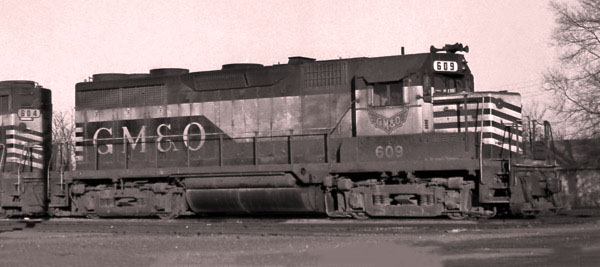 The next locomotive I modeled for the G.M.& O. was a GP-35. The first second-generation diesels on the G.M.& O. were GP-30's. They rode on Alco B-B trucks which came from Alco trade-ins (not necessarily trade-ins from the G.M.& O.). Several years later, GP-35's were purchased and they also rode on Alco trucks. Both the GP-30's and the GP-35's had a distinctive black and white paint scheme. Just before the IC / G.M.& O. merger, I took a number of pictures of G.M.& O. equipment realizing it was "now or never." One of my favorite shots was of GP-35 No. 609 at Laurel, Mississippi.
So I decided to model 609. A Central Locomotive Works GP-35 was used with Alco trucks. The kit was assembled as per the instructions and went together in a straightforward manner, even considering this was the first brass locomotive kit I ever built! I think what did make it go together well was the use of a 250 watt soldering iron for the heavy work; anything smaller couldn't have put out enough heat to do the job. Again my friend Gordon Payne painted it using Scalecoat paint. I used Champ Decal Set E-229 to letter it.
The next locomotive I modeled for the G.M.& O. was a GP-35. The first second-generation diesels on the G.M.& O. were GP-30's. They rode on Alco B-B trucks which came from Alco trade-ins (not necessarily trade-ins from the G.M.& O.). Several years later, GP-35's were purchased and they also rode on Alco trucks. Both the GP-30's and the GP-35's had a distinctive black and white paint scheme. Just before the IC / G.M.& O. merger, I took a number of pictures of G.M.& O. equipment realizing it was "now or never." One of my favorite shots was of GP-35 No. 609 at Laurel, Mississippi.
So I decided to model 609. A Central Locomotive Works GP-35 was used with Alco trucks. The kit was assembled as per the instructions and went together in a straightforward manner, even considering this was the first brass locomotive kit I ever built! I think what did make it go together well was the use of a 250 watt soldering iron for the heavy work; anything smaller couldn't have put out enough heat to do the job. Again my friend Gordon Payne painted it using Scalecoat paint. I used Champ Decal Set E-229 to letter it.
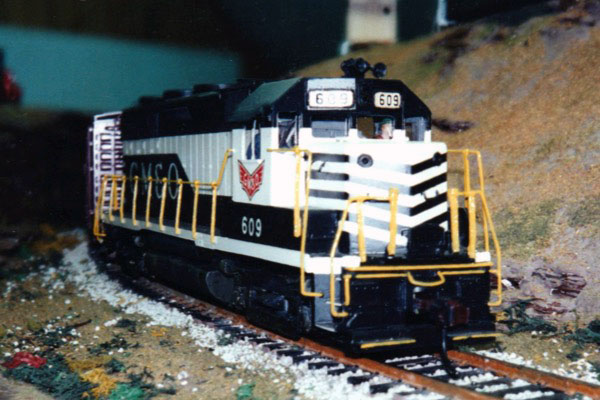 I had obtained a No. 55-76 Walthers set to use, but discovered that the "&" wasn't correct in the Walthers set. It is in the Champ set. One thing I added was 5/8's inch brass tubes for the cab and rear headlights. These were soldered to the inside of the headlight openings and then a bulb was inserted into them. These tubes not only hold the bulbs but prevent light spillage into the cab. A cab interior was installed using a P&D Hobby Shop No. D2715 EMD cab interior kit. The P&D floor had to be cut in the middle so that the interior kit could be installed one side at a time; otherwise it wouldn't go in. An engineer and front-end brakeman was also installed. I liked the appearance of 609 as a new locomotive so did very little weathering except for the trucks.
I had obtained a No. 55-76 Walthers set to use, but discovered that the "&" wasn't correct in the Walthers set. It is in the Champ set. One thing I added was 5/8's inch brass tubes for the cab and rear headlights. These were soldered to the inside of the headlight openings and then a bulb was inserted into them. These tubes not only hold the bulbs but prevent light spillage into the cab. A cab interior was installed using a P&D Hobby Shop No. D2715 EMD cab interior kit. The P&D floor had to be cut in the middle so that the interior kit could be installed one side at a time; otherwise it wouldn't go in. An engineer and front-end brakeman was also installed. I liked the appearance of 609 as a new locomotive so did very little weathering except for the trucks.
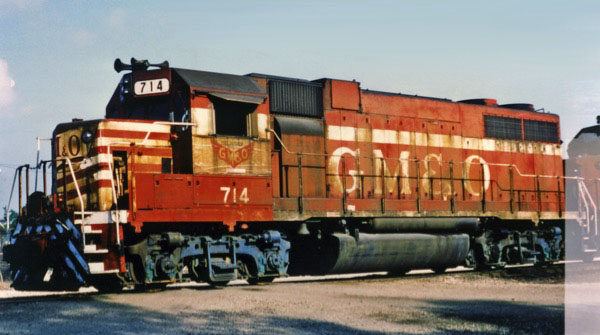 For the third G.M.& O. locomotive I used a Weaver undecorated GP-38. The GP-38's were the last locomotives purchased by the railroad before the merger, and they and the SD-40's were painted in a red and white scheme. I ordered a GP-38 when they were first advertised, but I had to wait almost a year to get it. I painted it using Floquil paint and lettered it using a Champ No. E-227 set. Chalks were used to weather it as I wanted 714 to have a more typical G.M.& O. look. It was numbered 714 because the only two prototype pictures I took of a G.M.& O. GP-38 were both of 714, separated by 17 years! It wasn't until I had finished 714 and was operating it that it was pointed out to me that the G.M.& O. GP-38's didn't have dynamic brakes as the Weaver unit does. So a needed modification is to obtain a body section to replace the dynamic brake section. Since the dynamic brake section is removable on the Weaver unit, it seems that a non-dynamic brake section will be produced. Another modification needed is a cab interior. Because of the way the Weaver body is made, I don't think the P&D EMD cab interior will go into it; thus a scratchbuilt interior will be required. Additional details to be installed on both the GP-38 and GP-35 are multi-unit hoses and windshield wipers. At first I planned on operating the GP-35 and the GP-38 MU-ed, but the GP-38 is faster than the GP-35 and therefore they don't do well together with a light train. With a heavy train of 20 to 30 cars they will work together but most of the time this is too long of a train to operate. So it looks like another Weaver GP-38 will have to be obtained and painted. A pair will sure look nice on the front of a through freight passing the GP-35 with a local freight!
For the third G.M.& O. locomotive I used a Weaver undecorated GP-38. The GP-38's were the last locomotives purchased by the railroad before the merger, and they and the SD-40's were painted in a red and white scheme. I ordered a GP-38 when they were first advertised, but I had to wait almost a year to get it. I painted it using Floquil paint and lettered it using a Champ No. E-227 set. Chalks were used to weather it as I wanted 714 to have a more typical G.M.& O. look. It was numbered 714 because the only two prototype pictures I took of a G.M.& O. GP-38 were both of 714, separated by 17 years! It wasn't until I had finished 714 and was operating it that it was pointed out to me that the G.M.& O. GP-38's didn't have dynamic brakes as the Weaver unit does. So a needed modification is to obtain a body section to replace the dynamic brake section. Since the dynamic brake section is removable on the Weaver unit, it seems that a non-dynamic brake section will be produced. Another modification needed is a cab interior. Because of the way the Weaver body is made, I don't think the P&D EMD cab interior will go into it; thus a scratchbuilt interior will be required. Additional details to be installed on both the GP-38 and GP-35 are multi-unit hoses and windshield wipers. At first I planned on operating the GP-35 and the GP-38 MU-ed, but the GP-38 is faster than the GP-35 and therefore they don't do well together with a light train. With a heavy train of 20 to 30 cars they will work together but most of the time this is too long of a train to operate. So it looks like another Weaver GP-38 will have to be obtained and painted. A pair will sure look nice on the front of a through freight passing the GP-35 with a local freight!
 In January 1995, the Southeast Louisiana O Scale Club took its portable layout to the Great American Train Show in Mobile, Alabama. Mobile was corporate headquarters for the G.M.& O. and we selected the G.M.& O. as our theme railroad for the show. We operated a lot of G.M.& O. equipment, including the FA and FB units on the front of a four car passenger train. A number of former G.M.& O. employees were there and we enjoyed long conversations with them as they reminisced about the good old days. One of the people we talked with was Mr. B. V. Bodie, the G.M.& O.'s Executive Vice President and General Manager before the merger. Mr. Bodie was the man who ran the railroad in the 1960's, and he was accompanied at the show by family members, including several of his grandchildren. They asked if we would stop the passenger train so they could take a picture of him and his grandchildren looking at it. Could anyone turn down a request like that? When he left he told us to "Keep up that good G.M.& O. modeling!"
In October 1995, our club operated the layout again in Mobile at a NMRA meeting. Mr. Bodie, his wife, and son came and I was able to show him both the GP-35 and the GP-38. It was really an experience to show them to the man who approved the ordering of the prototypes years ago!
In January 1995, the Southeast Louisiana O Scale Club took its portable layout to the Great American Train Show in Mobile, Alabama. Mobile was corporate headquarters for the G.M.& O. and we selected the G.M.& O. as our theme railroad for the show. We operated a lot of G.M.& O. equipment, including the FA and FB units on the front of a four car passenger train. A number of former G.M.& O. employees were there and we enjoyed long conversations with them as they reminisced about the good old days. One of the people we talked with was Mr. B. V. Bodie, the G.M.& O.'s Executive Vice President and General Manager before the merger. Mr. Bodie was the man who ran the railroad in the 1960's, and he was accompanied at the show by family members, including several of his grandchildren. They asked if we would stop the passenger train so they could take a picture of him and his grandchildren looking at it. Could anyone turn down a request like that? When he left he told us to "Keep up that good G.M.& O. modeling!"
In October 1995, our club operated the layout again in Mobile at a NMRA meeting. Mr. Bodie, his wife, and son came and I was able to show him both the GP-35 and the GP-38. It was really an experience to show them to the man who approved the ordering of the prototypes years ago!
If this article has wet your appetite to model something G.M.& O. but you don't know how you would operate it after building it, take heart! Just run a G.M.& O. freight train on trackage rights over your line. The G.M.& O. operated into three of its major terminals (New Orleans, Memphis, and Birmingham) over trackage rights on other railroads, so it would be very prototypical to do the same. Any of the locomotives discussed plus an caboose appropriately painted is all you need for an additional train and increased traffic on your line.
John C. Hawkins
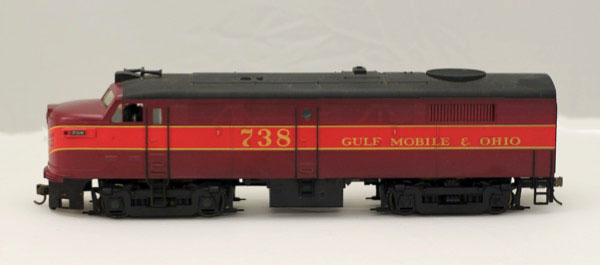
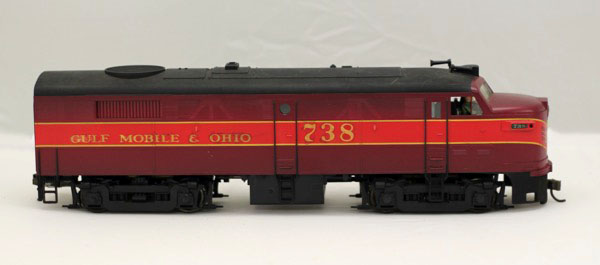
Gulf Mobile & Ohio #738
Aug 2020 / RWH


Aug 2020 / RWH


Gulf Mobile & Ohio #205
Aug 2020 / RWH


Gulf Mobile & Ohio #7180
Aug 2020 / RWH


Gulf Mobile & Ohio "Orange Grove"
Aug 2020 / RWH


Gulf Mobile & Ohio #2053
Aug 2020 / RWH


Gulf Mobile & Ohio #5394
Aug 2020 / RWH


Gulf Mobile & Ohio #2503
Aug 2020 / RWH
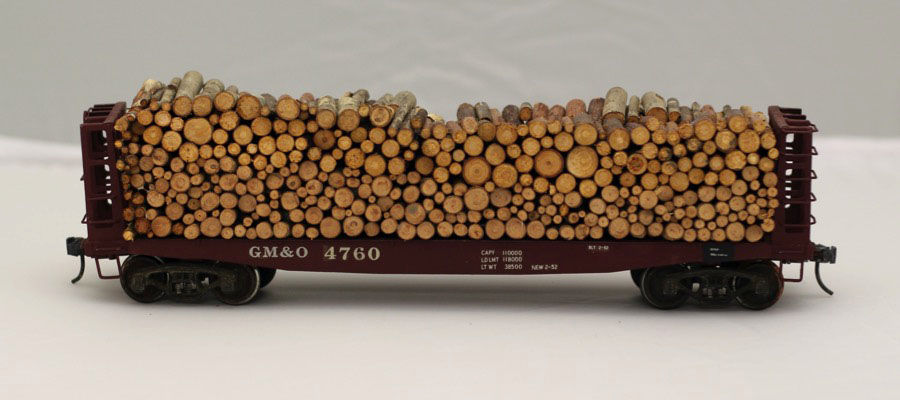
Gulf Mobile & Ohio #4760
Aug 2020 / RWH
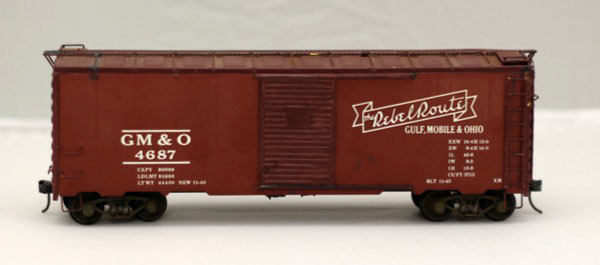
Gulf Mobile & Ohio #4687
Aug 2020 / RWH

Gulf Mobile & Ohio #26464
Aug 2020 / RWH

Gulf Mobile & Ohio #26631
Aug 2020 / RWH
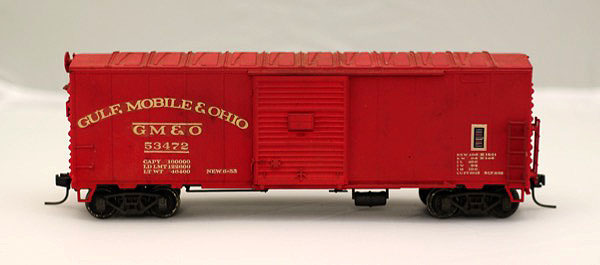
Gulf Mobile & Ohio #53472
Aug 2020 / RWH
 In the 1950's and 1960's many railfans were enthusiastic followers of the Gulf, Mobile & Ohio Railroad. The G.M.& O. stretched from Chicago and St. Louis down to New Orleans and Mobile, passing through Illinois, Kentucky, Tennessee, Mississippi, Alabama and Louisiana to arrive at the two Gulf ports it served. Powering the freight trains of the G.M.& O. were a number of interesting first and second generation diesel locomotives. The G.M.& O. was the first major Class 1 railroad to completely dieselize and this was done using both Alco and EMD cab units for road work and Alco units for switchers.
In the 1950's and 1960's many railfans were enthusiastic followers of the Gulf, Mobile & Ohio Railroad. The G.M.& O. stretched from Chicago and St. Louis down to New Orleans and Mobile, passing through Illinois, Kentucky, Tennessee, Mississippi, Alabama and Louisiana to arrive at the two Gulf ports it served. Powering the freight trains of the G.M.& O. were a number of interesting first and second generation diesel locomotives. The G.M.& O. was the first major Class 1 railroad to completely dieselize and this was done using both Alco and EMD cab units for road work and Alco units for switchers.
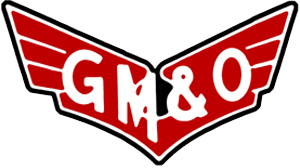 If this article has wet your appetite to model something G.M.& O. but you don't know how you would operate it after building it, take heart! Just run a G.M.& O. freight train on trackage rights over your line. The G.M.& O. operated into three of its major terminals (New Orleans, Memphis, and Birmingham) over trackage rights on other railroads, so it would be very prototypical to do the same. Any of the locomotives discussed plus an caboose appropriately painted is all you need for an additional train and increased traffic on your line.
If this article has wet your appetite to model something G.M.& O. but you don't know how you would operate it after building it, take heart! Just run a G.M.& O. freight train on trackage rights over your line. The G.M.& O. operated into three of its major terminals (New Orleans, Memphis, and Birmingham) over trackage rights on other railroads, so it would be very prototypical to do the same. Any of the locomotives discussed plus an caboose appropriately painted is all you need for an additional train and increased traffic on your line.

